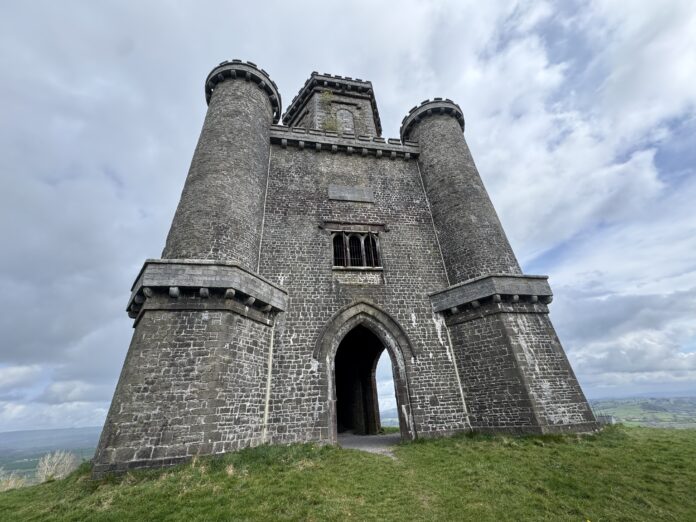Perched majestically atop a verdant hillside in the Towy Valley, Paxton Tower stands as a striking 36 foot Neo Gothic monument that has captured the imagination of visitors for more than two centuries. This distinctive triangular folly, with its three corner turrets rising against the Welsh sky, tells a fascinating story of wealth, ambition, political intrigue, and lasting friendship. For any traveler exploring the beautiful landscapes of South Wales, Paxton Tower offers not just breathtaking panoramic views but also a window into one of the most colourful characters of the early 19th century.
The Remarkable Life of Sir William Paxton
Sir William Paxton was born in 1744 to a Scottish family originally from Auchencrow near Paxton in Berwickshire. His father, John Paxton, worked as chief clerk to Archibald Stewart, a Scottish wine merchant who had become Lord Provost of Edinburgh. However, the family’s fortunes took a dramatic turn when Bonnie Prince Charlie marched on Edinburgh in 1745. Stewart’s lukewarm opposition to the Highland army led to his arrest and imprisonment in the Tower of London, though he was eventually found not guilty. The scandal prompted the Stewart family to relocate their business to London, taking the Paxtons with them.
From Sailor to Fortune Seeker in India
On June 1, 1764, young William Paxton walked from his family’s London apartment to the Berkeley Square home of Robert Clive, carrying a letter of recommendation. This meeting would change his life forever. He became a free mariner on a privateer ship for the East India Company, plying trade between different ports across Asia. His destination was Calcutta, where he would work alongside Charles Cockerell, brother of the renowned architect Samuel Pepys Cockerell.
Paxton proved to be extraordinarily talented at the mercantile arts, quickly understanding the intricacies of trade in India. By 1774, Paxton became Assay Master to the Bengal Presidency, and in 1778 he succeeded as Master of the Mint of Bengal. This position placed him in an extremely important role as the official issuer of the Sicca rupee, giving him tremendous influence and opportunity for profit.
The Agency House Empire
After The India Act 1784, when East India Company servants were no longer permitted to trade privately, Paxton seized upon a golden opportunity. He established an agency house, Paxton, Cockerell & Trail, which offered banking facilities and money remittance services to wealthy East India Company employees who could no longer use company channels. By providing financial services to the wealthiest and most powerful officials, agency house proprietors like Paxton became indispensable to the community.
The business was wildly successful. Paxton, Cockerell & Trail even financed Governor General Richard Wellesley in the war against Tipu Sultan of Mysore in 1798 to 1799, a conflict that dramatically increased East India Company territory. When Paxton advertised his personal assets for sale in the Calcutta Gazette in 1785, they included three houses and eight horses, while the normal level for a rich British expatriate in India would have been one house and two horses.

A Hasty Departure and Controversy
Paxton’s Indian adventure came to an abrupt end, though not entirely by his choice. He was forced to leave the Company in a hurry when it was discovered that he had been trading illegally with the Dutch at a time when the two countries were enemies. As it was illegal and against company rules for administrators to trade with foreign powers, Paxton was in a weak position. Despite having powerful sponsors throughout the company hierarchy, the London board was not enthusiastic about openly approving an illegal operation.
Rather than face disgrace, Paxton formed a partnership with Charles Cockerell and placed all assets and operations of his Indian businesses into this new venture. In February 1785, he departed India with his six year old daughter, making the six month journey back to Britain with substantial wealth accumulated from his years in the subcontinent.
Return to Wales and Political Ambitions
Upon his return to Britain, Paxton used his considerable fortune to establish himself as a Welsh gentleman. He purchased Middleton Hall in Carmarthenshire, where the National Botanic Garden of Wales stands today. He also received a knighthood in 1803, becoming Sir William Paxton.
But Paxton had grander ambitions than simply living as a country squire. He set his sights on political power, seeking to become a Member of Parliament. His first attempt came at the 1802 general election when he stood for the Carmarthenshire seat.
The Election, The Defeat, and The Folly of Spite
The 1802 parliamentary election campaign in Carmarthenshire was an extraordinarily expensive affair. Paxton spent £15,690 in total attempting to convince constituents to vote for him, a staggering sum for the time. As part of his campaign promises, he pledged to build a new bridge across the River Tywi for the people of Carmarthenshire.
Despite his enormous expenditure, Paxton lost the election by a mere 45 votes. The defeat left him bitter and determined to make a statement. When he lost the election, Paxton used the money that would have gone to building the promised bridge to construct the tower instead, which local residents called the ‘Folly of Spite’.
However, this may not be the complete story. While political revenge certainly played a role, Paxton also had genuine affection for Admiral Lord Nelson, who had died at the Battle of Trafalgar in October 1805. Paxton was a friend of Admiral Lord Nelson and wanted to commemorate his victories. It’s quite possible that the tower served multiple purposes: a memorial to a fallen hero, a demonstration that his fortune remained intact despite the costly election, and perhaps even a viewing platform to watch his horses race between Middleton and Tenby.
The Construction and Architecture of Paxton Tower
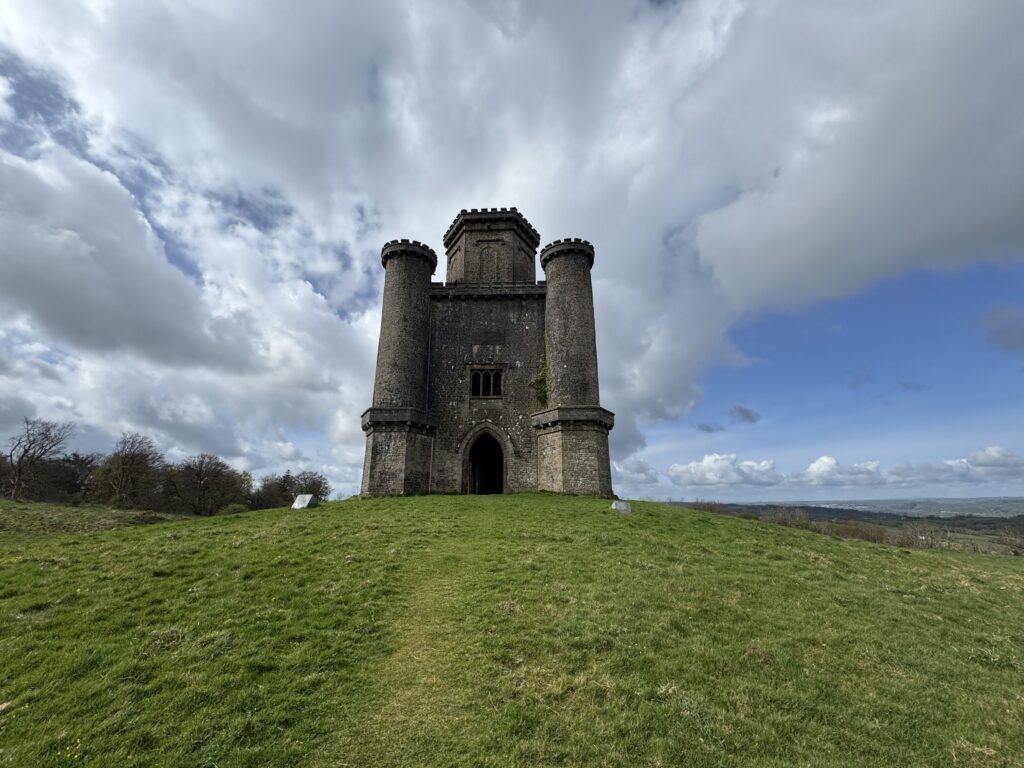
Around 1806, Paxton called in architect Samuel Cockerell to design a neoclassical folly to commemorate the life of Admiral Nelson. Cockerell was not a surprising choice of architect, as Paxton had served with his brother Charles in India. Samuel Pepys Cockerell also helped Paxton design a new mansion at Middleton Hall.
The tower’s construction took place between 1806 and 1811, depending on which historical source you consult. The tower’s design features a triangular base with turrets at each corner, rising to a height of 36 feet. The structure was built in military Gothic style, with crenellated parapets that give it a castle like appearance.
These windows were commissioned from an artist named Mr. Grey and were considered masterpieces of their time. By 1903, however, local newspapers expressed concern that the tower was exhibiting evidence of decay. Fearing for the safety of the painted glass panels, descendants of the Abadam family gave the glass to the Carmarthenshire Museum for safekeeping before selling the estate in 1909. Today, coloured glass from one of the windows can still be seen at the Carmarthen Museum at Abergwili.
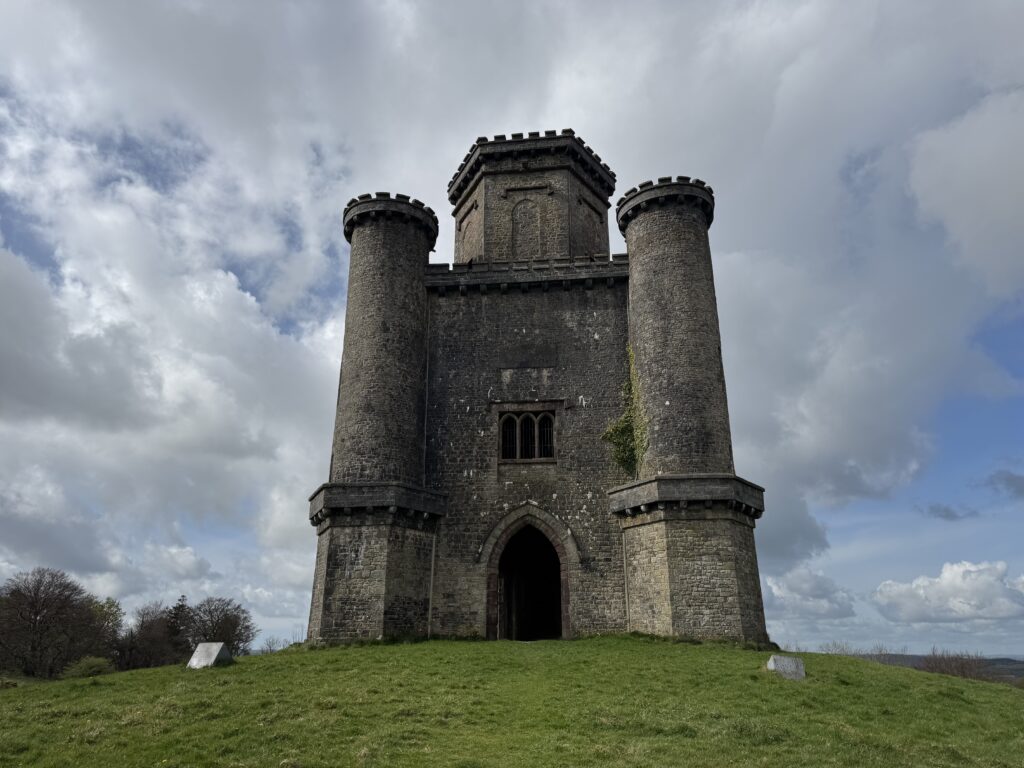
Inside the Tower
The interior of Paxton Tower was designed for both function and entertainment. On the first floor there is a banqueting room, while the second floor offers a hexagonal prospect room surrounded by roof terraces. Above that was an upper apartment with stained glass windows depicting scenes from Nelson’s life.
The Inscriptions
There were originally inscriptions on the tower on three sides, in English, Welsh, and Latin. The English inscription read: “To the invincible Commander, Viscount Nelson, in commemoration of the deeds before the walls of Copenhagen, and on the shores of Spain; of the empire every where maintained by him over the Seas; and of the death which in the fulness of his own glory, though ultimately for his own country and for Europe, conquering, he died; this tower was erected by William Paxton.”
The tower was therefore not just a folly or an act of political spite, but also a genuine memorial, a cenotaph to one of Britain’s greatest naval heroes.
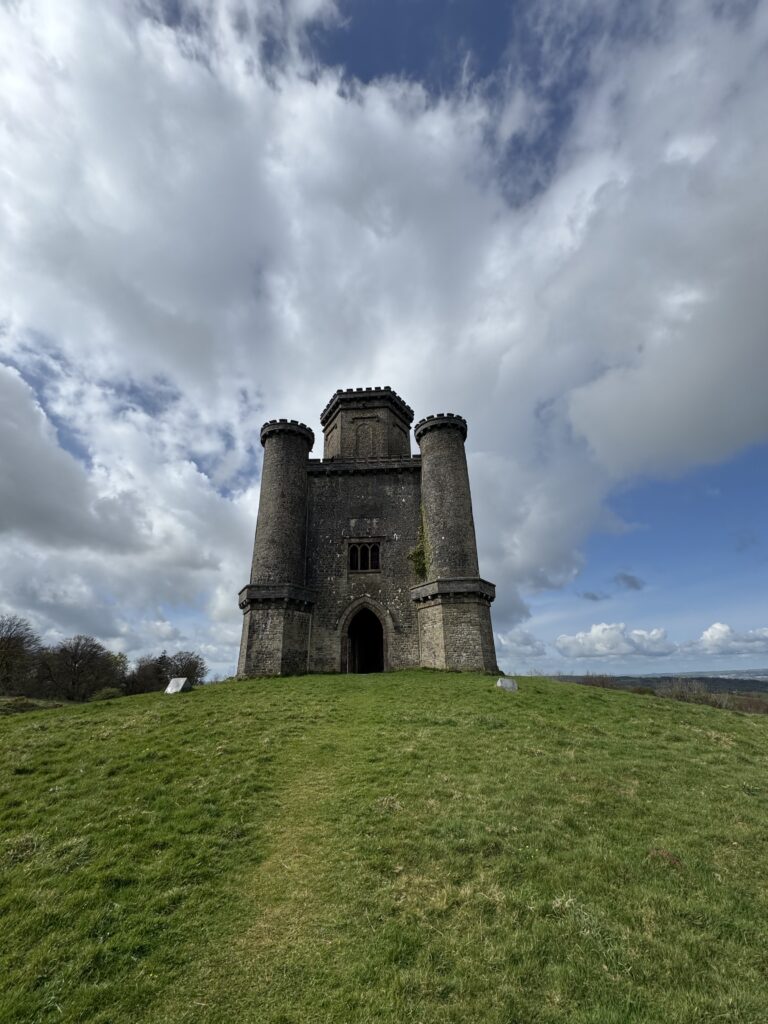
Stories and Legends Surrounding the Tower
The Viewing Platform for Horse Racing
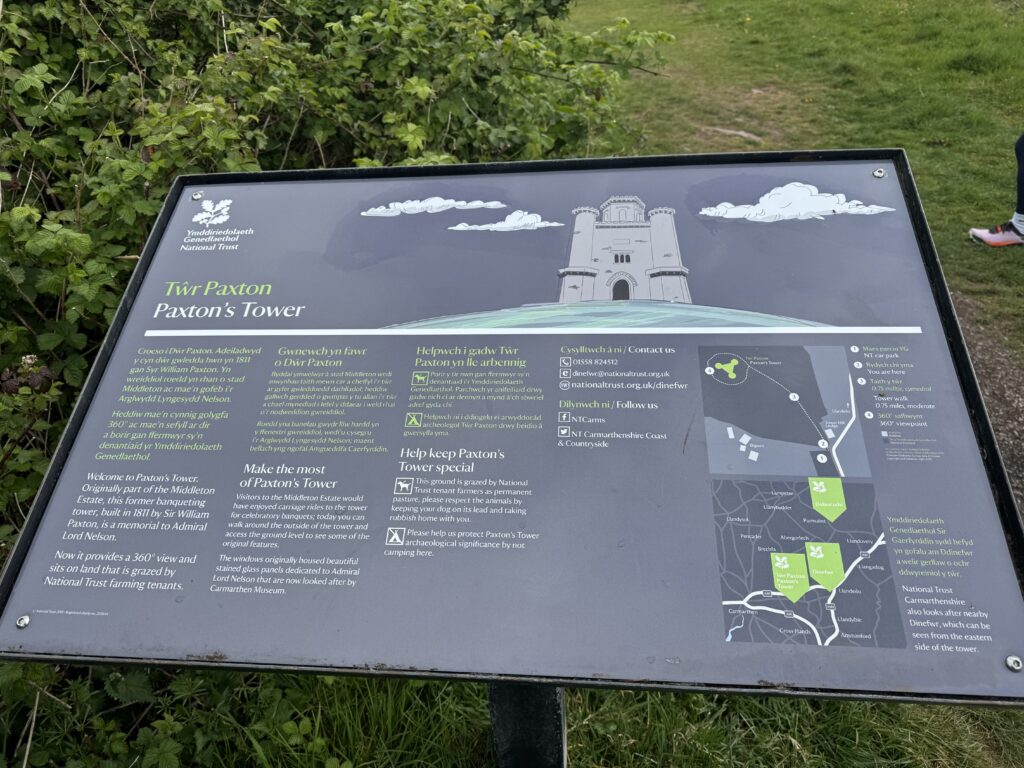
One intriguing theory about the tower’s purpose suggests practical as well as commemorative functions. The tower may have been used as a viewing platform for Paxton to watch his horses racing between Middleton and Tenby. Given the tower’s commanding position over the Towy Valley, it would have provided an excellent vantage point for such activities, combining Paxton’s love of sport with his taste for architectural grandeur.
A Statement of Continued Wealth
Another explanation is that Paxton wanted to prove to the voters of Carmarthen that his fortune had not been spent during the costly 1802 election campaign, which he lost by a measly 45 votes. By constructing such an impressive monument so soon after the election, he demonstrated that he remained a man of substantial means and influence, regardless of his political defeat.
Near Destruction in the 20th Century
The tower’s survival into the modern era was not guaranteed. In 1934, the future of the tower looked precarious, and it was dismissed by one onlooker as a ‘vast and useless sentinel’. The situation became critical in 1950. The Western Mail reported that heritage bodies were powerless as the building was not scheduled as an ancient monument. Two years later, a preservation order was obtained just in time: the farmer, fearing that falling masonry would concuss his cattle, planned to demolish the tower and use the stones to erect a cow house.
Today, the tower is cared for by the National Trust as part of the Dinefwr estate, ensuring its preservation for future generations.
The Views from Paxton Tower
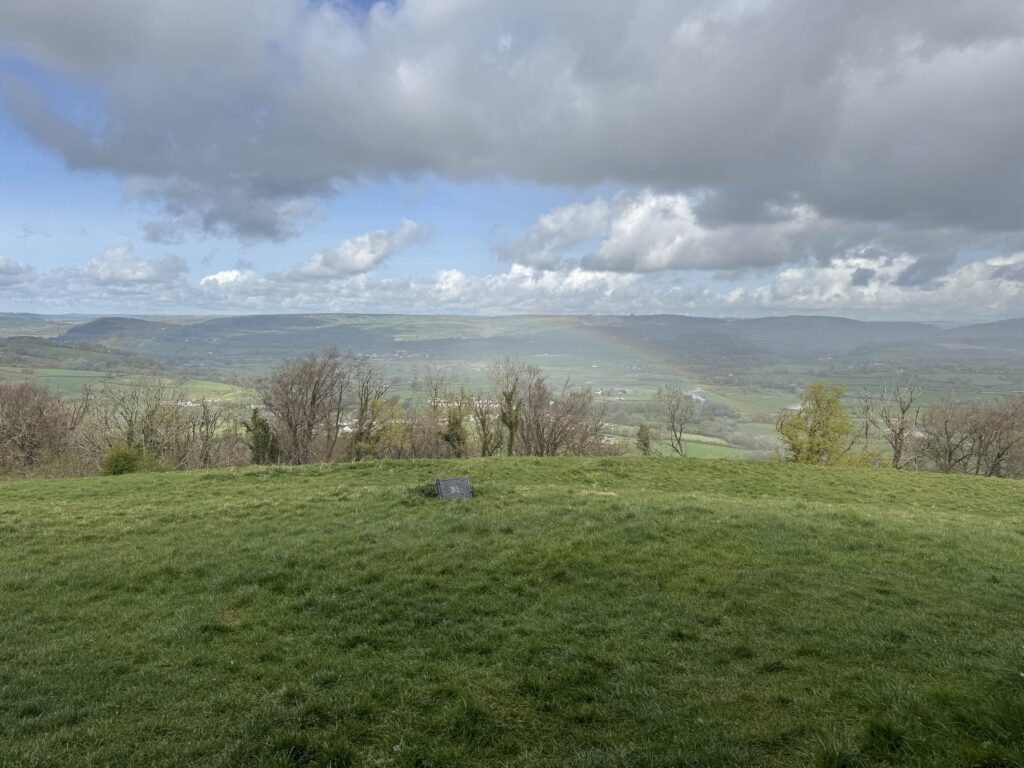
The primary reason most visitors make the journey to Paxton Tower today is for the spectacular views it commands. From its elevated position, you can see for miles across the beautiful Towy Valley. The tower provides expansive views over the Towy Valley and the National Botanic Garden of Wales.
More specifically, one acquires striking views over two dramatic sets of ruins: the castles of Dryslwyn and Dinefwr. The medieval allusions of the folly’s Gothic architecture resonate beautifully with the ancient castle ruins visible in the distance, creating layers of historical resonance across the landscape.
On a clear day, visitors report being able to see the Brecon Beacons and Black Mountains in the distance. The tower is visible from miles away across Carmarthenshire, serving as a distinctive landmark that has oriented travellers for more than two centuries.
How to Get to Paxton Tower
By Car
Paxton Tower is located near the village of Llanarthne in Carmarthenshire. The car park is signposted from the B4300 at Llanarthney, opposite the Emlyn Arms public house. The postcode for the area is SA32 8HX.
If you’re driving from Carmarthen, head southeast on A40 towards Llandeilo. After approximately 6 miles, take the exit toward A476/Llanarthne. Continue on A476 for about 2 miles until you reach Llanarthney.
From Llanarthne village centre, take the minor road south towards Pen Heol Fawr. Branch left at the first fork, and then turn left again at a four way crossing. You will find a parking area for the tower on your left after a few hundred metres.
Note that many visitors have commented that signage can be poor, especially when approaching from certain directions. Using GPS navigation is highly recommended. The car park is about 2 miles from the B4300 turn off.
Parking
Parking at Paxton Tower is free, though voluntary contributions to the National Trust are welcome. The car park is laid to compacted stones and can accommodate approximately 8 vehicles, though the lane leading to it is quite narrow.
The Walk to the Tower
From the parking area, simply walk past the former gatekeeper’s lodge, through a gate, and you will see the tower at the top of the hill ahead of you. Access to the tower is across a steep field, so visitors should be prepared for a short but moderately challenging uphill walk.
Many reviewers advise wearing appropriate footwear, particularly wellies or hiking boots, as the field can be wet and muddy. The field is also used for grazing livestock, so watch your step. The walk takes approximately 10 to 15 minutes from the car park.
Access is not really suitable for wheelchairs due to the steep gradient and uneven terrain.
By Public Transport
To reach Paxton Tower by public transport, take a bus from Carmarthen to Llandeilo. Buses like the X11 operate this route regularly. Once you arrive in Llandeilo, transfer to a local bus heading towards Llanarthney. The bus stop closest to Paxton Tower is within walking distance, approximately a 15 minute walk.
For current bus schedules and route information, check Traveline Cymru or call 0871 200 22 33.
Combining with Other Attractions
The tower is within a reasonable walk of the National Botanic Garden of Wales, though you will have to walk along the lanes from the northern boundary of the Garden. Many visitors combine a trip to the tower with a visit to the botanic gardens, which occupy the former Middleton Hall estate where Sir William Paxton once lived.
There is also a circular walking route that connects the tower with the National Botanic Garden of Wales, covering approximately 6 miles. This makes for an excellent day out, combining cultural history with beautiful Welsh countryside.
Opening Times and Admission
The tower is open daily and admission is free. There are no set opening hours as it’s an outdoor monument, so it’s accessible at any reasonable time during daylight hours. However, weather conditions can affect accessibility, particularly in winter when the fields can become very muddy.
What to Expect
There are no facilities at the tower itself, including no toilets, cafes, or visitor centres. Visitors should bring their own refreshments, especially if planning a picnic. The site can be breezy, so pack a windproof jacket.
There is a lack of information available on site about the tower’s history and significance. The absence of explanation boards detracts from the experience, which is why reading about its history beforehand (like in this article!) will greatly enhance your visit.
Access to the interior is limited. You can walk through the tower arch and out the other side, and sometimes the first floor banqueting room is accessible via stairs in one of the corner turrets. However, access to the upper levels is often closed, with the gate to the top locked. The prospect room windows have been bricked up for safety reasons.
Despite these limitations, the primary attraction, the magnificent 360 degree views over the Towy Valley, is always available and more than justifies the visit.
Frequently Asked Questions
Is Paxton Tower free to visit?
Yes, visiting Paxton Tower is completely free. There is also free parking available at the site, though donations to the National Trust are welcome as they maintain the monument.
Can you go inside Paxton Tower?
You can walk through the ground level archway, and sometimes access is available to the first floor banqueting room via a spiral staircase in one of the corner turrets. However, the upper levels including the hexagonal prospect room are typically closed to visitors for safety reasons.
How long does it take to visit Paxton Tower?
Most visitors spend between 30 minutes to an hour at the tower. This includes the 10 to 15 minute walk up from the car park, time to walk around the tower, take photographs, and enjoy the views. Many people bring picnics and stay longer to soak in the atmosphere and scenery.
Is Paxton Tower suitable for children?
Yes, children generally enjoy visiting the tower, especially the walk through the fields which may contain sheep or cattle. However, parents should supervise children carefully due to the steep field, uneven ground, and the drop offs around the tower structure itself. The walk up can be tiring for very young children.
Is Paxton Tower wheelchair accessible?
Unfortunately, no. The access from the car park involves crossing a steep field with uneven terrain, making it unsuitable for wheelchair users or those with significant mobility issues.
What should I wear to visit Paxton Tower?
Sturdy footwear is essential, preferably waterproof hiking boots or wellies, as the field can be muddy and may contain animal droppings. The site is exposed and can be windy, so bring layers and a windproof jacket. In summer, sun protection is advisable as there’s little shade.
When is the best time to visit Paxton Tower?
The tower is accessible year round, but spring through autumn generally offers the best weather conditions and easiest walking. Clear days are ideal for enjoying the panoramic views. Sunrise and sunset are particularly beautiful times to visit for photographers. However, winter visits can be magical if you’re prepared for muddy conditions.
Are dogs allowed at Paxton Tower?
Yes, dogs are welcome but must be kept under close control, especially as the fields are used for grazing livestock. Dogs should be kept on leads around livestock.
What’s nearby to combine with a visit to Paxton Tower?
The National Botanic Garden of Wales is the closest major attraction and occupies Sir William Paxton’s former estate at Middleton Hall. The historic market town of Llandeilo is also nearby, offering shops, cafes, and restaurants. Other nearby attractions include Dinefwr Castle, Carreg Cennen Castle, and the town of Carmarthen.
Can I have a picnic at Paxton Tower?
Absolutely! The grounds around the tower are ideal for picnics, with stunning views to enjoy while you eat. Just remember to take all litter away with you as there are no bins on site.
Who owns and maintains Paxton Tower?
The tower is owned and maintained by the National Trust as part of the Dinefwr estate. The nearby gatekeeper’s lodge is maintained by the Landmark Trust and can be rented as a self catering holiday cottage.
Is there mobile phone signal at Paxton Tower?
Mobile coverage can be patchy in this rural area. It’s advisable not to rely on your phone for navigation and to download offline maps before visiting.
Was Paxton Tower really built out of spite?
While locals called it the “Folly of Spite” because Paxton built it instead of the bridge he promised during his election campaign, the truth is more nuanced. It was genuinely built as a memorial to Admiral Lord Nelson, Paxton’s friend who died at Trafalgar. However, Paxton’s political bitterness after losing the 1802 election by just 45 votes likely influenced his decision to create such a prominent monument that would remind everyone of his continuing wealth and status.
What does “folly” mean in architectural terms?
A folly is a building constructed primarily for decoration rather than practical use, often featuring unusual or exotic designs. Follies were popular among wealthy landowners in the 18th and 19th centuries as status symbols and landscape features. Paxton Tower is a perfect example, combining Gothic romanticism with commemoration and perhaps a touch of vanity.
Paxton Tower on top of the hill
Paxton Tower stands as far more than just another Welsh monument. It represents the ambitions, rivalries, friendships, and complexities of early 19th century Britain. From Sir William Paxton’s controversial fortune made in India to his bitter political defeat and his lasting tribute to Admiral Nelson, every stone tells a story.
For modern travellers, the tower offers a perfect combination of history, architecture, and natural beauty. The short but rewarding walk to the summit, the impressive Gothic structure, and above all the breathtaking views across the Towy Valley make it a worthwhile destination for anyone exploring Carmarthenshire.
Whether you’re a history enthusiast fascinated by tales of East India Company merchants and Napoleonic era heroes, a photographer seeking dramatic Welsh landscapes, or simply someone who enjoys a pleasant walk with rewarding views, Paxton Tower will not disappoint. Just remember to wear sensible shoes, bring a camera, and perhaps pack a picnic to enjoy while contemplating the remarkable story of the Scottish born adventurer who built this lasting monument to ambition, memory, and more than a little spite.
The tower has stood for over 200 years, weathering storms both literal and metaphorical, from nearly being demolished for cattle shelter to its current protected status. It continues to serve Paxton’s original purpose: to be seen from miles around, a permanent reminder of one man’s extraordinary journey from Edinburgh to Calcutta and back to the green hills of Wales.
Also visit National Botanical Gardens of Wales which is close by. Full Article below:

